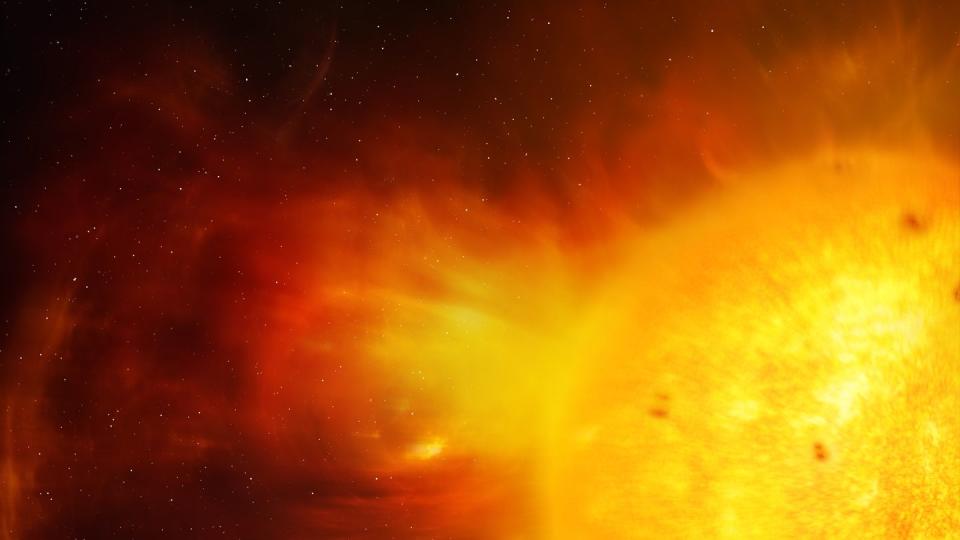This Ancient Solar Storm Would Have Wiped Out Current Satellite System

Scientists uncovered the world’s largest radiocarbon spike 14,300 years ago by analyzing French Alps tree rings.
A spike of that size, caused by a solar storm, would be enough to likely crush our modern technologies, including telecommunications, satellites, and energy grids.
Nine similar events have been identified in the last 15,000 years, but the newly discovered episode is the largest ever found.
When humans directly observed a large solar storm in 1859 it provided quite the technological disruption, destroying telegraph machines the world over—and producing a night-time aurora so bright birds began singing thinking the sun was rising. What happened in 1859 pales in comparison to a newly discovered radiocarbon spike, likely brought on by a solar storm, from 14,300 years ago.
At an entire order-of-magnitude grater in size than the 1859 affair, the 14,300-year-old storm is the largest known in the history of the world and if it occurred today could potentially destroy our telecommunications abilities, satellite systems, and electricity grids.
Locating this historical event took a team of scientists analyzing ancient tree rings from the French Alps. The findings, published in Philosophical Transactions of the Royal Society A: Mathematical Physical and Engineering Sciences, highlight how any such similar occurrence could produce catastrophic results for modern technology.
“Extreme solar storms could have huge impacts on Earth,” Tim Heaton, professor of applied statistics in the School of Mathematics at the University of Leeds, says in a news release. “Such super storms could permanently damage the transformers in our electricity grids, resulting in huge and widespread blackouts lasting months. They could also result in permanent damage to the satellites that we all rely on for navigation and telecommunication, leaving them unusable.”
That all sounds just peachy.
Scientists have uncovered nine extreme solar storms, dubbed Miyake Events, in the last 15,000 years. The most recent Miyake Events—much larger than the telegraph-busting 1859 episode, mind you—occurred in 993 AD and 774 AD. This newly identified storm is from 14,300 years ago and the largest ever found, roughly twice the size of the two recent events.
The team measured radiocarbon levels in ancient trees preserved within the eroded banks of the Drouzet River in the southern French Alps to date the storm. The team linked the widths of individual tree rings in multiple trunks, then pieced together separate trees to create a longer timeline using a method called dendrochronology, which Cecile Miramont, associate professor of paleoenvironments and paleoclimates at IMBE, Aix-en-Provence University, says allows the team to “discover invaluable information on past environmental changes and measure radiocarbon over an uncharted period of solar activity.”
By comparing radiocarbon spikes with measurements of beryllium, a chemical element found in Greenland ice cores, the team determined a solar storm ejected an unheard-of volume of energetic particles into Earth’s atmosphere.
“Radiocarbon is constantly being produced in the upper atmosphere through a chain of reactions initiated by cosmic rays,” Edouard Bard, professor of climate and ocean evolution at the College de France and CEREGE, says in a news release. “Recently, scientists have found that extreme solar events, including solar flares and coronal mass ejections, can also create short-term bursts of energetic particles which are preserved as huge spikes in radiocarbon production occurring over the course of just a single year.”
Fully understanding the Miyake Events is tricky because we haven’t had instruments observing them. The research team says this means we don’t yet know what causes extreme solar storms to occur, how frequently they appear, or if there could be some way to predict them.
“Direct instrumental measurements of solar activity only began in the 17th century with the counting of sunspots,” Bard says. “Nowadays, we also obtain detailed records using ground-based observatories, space probes, and satellites. However, all these short-term instrumental records are insufficient for a complete understanding of the sun.”
He adds that radiocarbon measured in tree rings alongside polar ice core beryllium offers the best way to view the sun’s historic behavior.
“A precise understanding of our past is essential if we want to accurately predict our future and mitigate potential risks,” Heaton says. “We still have much to learn. Each new discovery not only helps answer existing key questions but can also generate new ones.”
You Might Also Like
